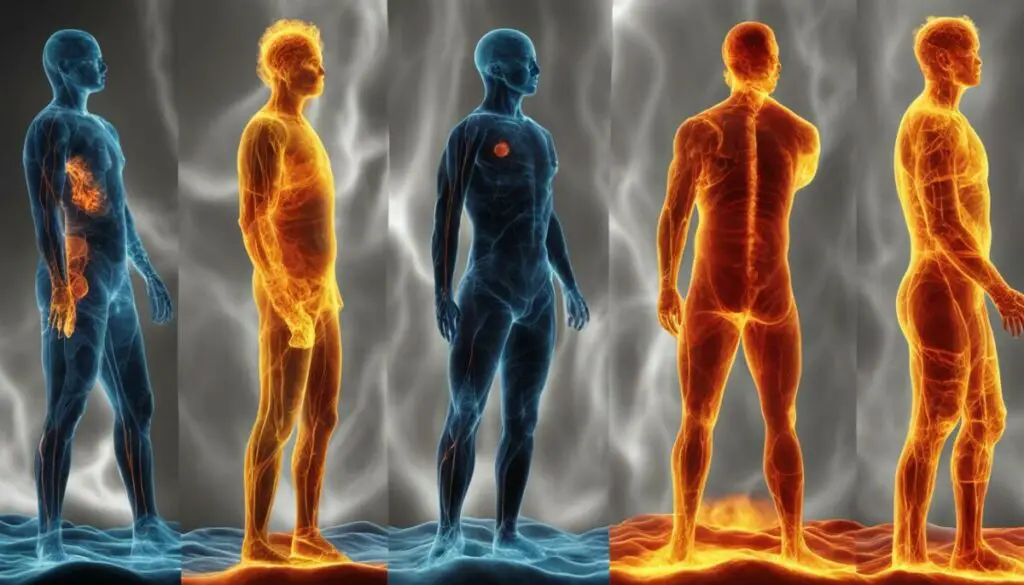Last Updated on 4 months by Francis
If you’ve ever wondered about the potential health risks associated with infrared waves, microwave waves, and radio waves, you’re not alone. In today’s modern world, we are surrounded by various forms of electromagnetic radiation, and understanding their effects on our health is crucial.
Firstly, it’s important to note that infrared waves, microwave waves, and radio waves are all forms of non-ionizing radiation. This means that they do not have enough energy to remove electrons from atoms and cause direct DNA damage, unlike ionizing radiation.
While non-ionizing radiation may not cause direct DNA damage, exposure to high levels of radiofrequency (RF) energy can result in heat absorption and tissue damage. Prolonged exposure to low levels of RF radiation may also have potential health effects.
In this article, we will delve deeper into the topic of non-ionizing radiation, explore its potential health risks, and discuss the various sources of RF energy in our everyday lives.
Contents
Key Takeaways:
- Non-ionizing radiation, including infrared waves, microwave waves, and radio waves, does not have enough energy to directly damage DNA.
- Exposure to high levels of RF energy can result in heat absorption and tissue damage.
- Prolonged exposure to low levels of RF radiation may have potential health effects.
- RF energy is used in various applications such as telecommunications, microwave ovens, and radar systems.
- Measuring RF energy involves assessing electric fields, magnetic fields, power density, and specific absorption rate (SAR).
What is Non-Ionizing Radiation?

Non-ionizing radiation refers to the lower frequencies in the electromagnetic spectrum, such as infrared, visible light, and RF radiation. While non-ionizing radiation does not possess enough energy to ionize atoms and cause direct DNA damage like ionizing radiation, it can still produce thermal effects in the body. High levels of infrared waves, microwave waves, and radio waves can result in heat absorption and possible tissue damage.
How is RF Energy Used?

RF energy, also known as radio frequency energy, plays a crucial role in various industries and technologies. Let’s explore the different applications of RF energy:
Telecommunications
One of the primary uses of RF energy is in the field of telecommunications. RF signals are used for broadcasting radio and television signals, enabling us to enjoy our favorite programs and stay informed. Cellular communication networks rely on RF energy to facilitate seamless wireless communication, allowing us to make calls, send text messages, and access the internet on our smartphones. Wi-Fi and Bluetooth devices also utilize RF energy to create wireless networks for data transfer and connectivity.
Microwave Ovens
RF energy is utilized in microwave ovens to heat food quickly and efficiently. Microwave ovens generate RF radiation, commonly in the microwave frequency range, which is absorbed by water molecules in the food. This absorption causes the water molecules to vibrate rapidly, generating heat and cooking the food. Thanks to RF energy, we can enjoy hot meals in a matter of minutes.
Radar Systems
Radar systems rely on RF energy to detect and track objects in various environments. Radar technology uses RF signals to emit pulses and measure the time it takes for the signals to return after bouncing off an object. This enables radar systems to determine the distance, speed, and direction of the detected objects. Radar has a wide range of applications, including air traffic control, weather monitoring, navigation systems, and military surveillance.
RF energy plays a crucial role in telecommunications, microwave ovens, and radar systems. Its versatility and ability to transmit information and generate heat make it an essential component of various technologies.
Measuring RF Energy

Measuring RF energy involves assessing various parameters to determine the intensity and absorption of electromagnetic waves. It can be quantified through the evaluation of electric and magnetic fields, power density, and the specific absorption rate (SAR).
The electric field measurement, expressed in volts per meter (V/m), assesses the strength of the electric component of the RF energy. It helps determine the potential exposure level of a specific electromagnetic field.
The magnetic field measurement, expressed in amperes per meter (A/m), evaluates the strength of the magnetic component of the RF energy. This measurement aids in understanding the magnetic field level generated by devices such as antennas and transmitters.
Power density, measured in watts per square meter (W/m²), quantifies the amount of RF energy flow per unit area. It provides valuable information about the intensity of RF energy in a particular space.
The specific absorption rate (SAR) measurement is used to assess the rate at which RF energy is absorbed by the human body. It is typically measured in watts per kilogram (W/kg) or milliwatts per gram (mW/g) and helps determine the potential impact of RF energy on human health.
| Measurement | Unit | Description |
|---|---|---|
| Electric Field | V/m | Assesses the strength of the electric component |
| Magnetic Field | A/m | Evaluates the strength of the magnetic component |
| Power Density | W/m² | Quantifies the amount of RF energy flow per unit area |
| Specific Absorption Rate (SAR) | W/kg or mW/g | Determines the rate at which RF energy is absorbed by the body |
Biological Effects of RF Energy
Exposure to RF energy can have various biological effects on the human body, particularly thermal effects resulting from the rapid heating of tissues. When individuals are exposed to high levels of RF radiation, it can lead to tissue damage and burns. However, it is important to note that there is currently no clear evidence to suggest that RF radiation directly causes cancer by damaging DNA. Ongoing research is being conducted to further explore the potential health effects associated with prolonged exposure to low levels of RF radiation.
While the exact biological effects of RF energy are still being studied, it is crucial to understand the potential risks involved. High levels of RF radiation can result in thermal effects, which can have harmful consequences for human tissues. Nonetheless, the direct link between RF radiation and the development of cancer through DNA damage remains inconclusive. Further research is necessary to determine the long-term effects of low-level RF radiation exposure on human health.
To gain a better understanding of the possible effects of RF radiation, researchers are examining the thermal effects caused by the rapid heating of tissues. The aim is to establish guidelines and safety measures that can protect individuals from potential harm. However, it is important to note that the current evidence does not definitively establish RF radiation as a major health risk.
Sources of RF Exposure

RF radiation can be encountered through various sources, both natural and human-made. Understanding these sources is crucial in assessing potential exposure levels and implementing appropriate safety measures.
Natural Sources:
- Solar Radiation: The sun emits electromagnetic radiation, including radio waves, as part of the electromagnetic spectrum. Although the intensity of solar radio waves is relatively low, prolonged exposure to direct sunlight can contribute to overall RF radiation exposure.
- Lightning Strikes: Thunderstorms generate powerful bursts of radio waves due to the discharge of atmospheric electricity. However, the exposure to RF radiation from lightning strikes is brief and sporadic.
- Radio Waves from the Earth: The Earth itself emits low-frequency natural radio waves, often referred to as Schumann resonances. These waves occur due to the interaction between the planet’s surface and the ionosphere.
Human-Made Sources:
- Broadcasting Signals: Television and radio broadcasting stations transmit RF signals to deliver audio and video content. These signals are broadcasted over a wide range of frequencies, depending on the specific transmission technology used.
- Cellular Communication: Cell phones and cell towers are a significant source of RF radiation. Cell phones emit RF waves to establish communication with nearby base stations, while cell towers transmit and receive signals to connect cellular networks.
- Wi-Fi and Bluetooth Devices: Wireless technologies like Wi-Fi routers, Bluetooth devices, and smart home systems utilize RF signals to enable wireless communication and data transfer.
- Radar Systems: Radar systems, used in aviation, weather monitoring, and military applications, emit high-frequency RF radiation to detect and track objects by measuring the time it takes for radio waves to bounce back after hitting the target.
- Microwave Ovens: Microwaves generate RF radiation to heat food. The microwaves produced by these ovens are contained within the appliance and pose minimal risk when used according to manufacturer instructions.
It is important to note that certain occupations may result in higher levels of RF exposure. For example, telecommunications technicians, radar operators, and healthcare workers operating medical equipment that utilizes RF radiation may experience elevated exposure levels as an inherent part of their work environment.
| Source of RF Exposure | Description |
|---|---|
| Natural Sources | Includes solar radiation, lightning strikes, and radio waves from the Earth itself |
| Broadcasting Signals | Transmitting RF signals for radio and television broadcasting |
| Cellular Communication | Cell phones and cell towers for wireless communication |
| Wi-Fi and Bluetooth Devices | Wireless technologies for data transfer and device connectivity |
| Radar Systems | Used in aviation, weather monitoring, and military applications |
| Microwave Ovens | Generating RF radiation to heat food |
RF Radiation and Health Risks

While RF radiation is not known to directly cause cancer by damaging DNA, exposure to high levels of RF energy can lead to heat absorption and tissue damage.
For example, high-frequency microwave radiation has been associated with eye and testicular damage, including cataracts and reproductive problems. Some studies suggest a potential link between microwave radiation and birth defects.
It is essential to be aware of the potential health risks associated with RF radiation and take appropriate precautions to minimize exposure.
The Effects of RF Radiation on the Body
Exposure to high levels of RF energy can result in heat absorption in the body, causing damage to tissues. When microwave radiation is absorbed by tissues, it can lead to various health issues, including damage to the eyes and testicles.
“The potential health risks associated with RF radiation, particularly high-frequency microwave radiation, are a cause for concern. Studies have shown a correlation between exposure to these frequencies and eye and testicular damage, as well as an increased risk of cataracts and reproductive problems.” – Dr. Sarah Johnson, Radiation Research Institute
While more research is needed to fully understand the long-term effects of RF radiation and its potential impact on human health, it is crucial to minimize exposure, especially in high-risk situations.
Recommended Safety Measures
To reduce the potential health risks associated with RF radiation, individuals can take the following precautions:
- Avoid prolonged exposure to high levels of RF energy
- Use hands-free devices or speakerphones when talking on cell phones
- Maintain a safe distance from sources of RF radiation
- Follow safety guidelines provided by regulatory bodies
By implementing these safety measures, individuals can minimize the potential negative impact of RF radiation on their health.
Safety Measures and Regulations
Ensuring the safety of workers is paramount when it comes to RF radiation exposure. Employers should implement engineering controls to minimize the risk of RF exposure in high-risk industries. These controls may include the use of shielding materials, enclosures, or equipment modifications to reduce RF radiation levels in the workplace.
To provide an additional layer of protection, it is crucial to equip workers with appropriate personal protective equipment (PPE). This may include protective clothing, gloves, eyewear, or respiratory masks designed to shield against RF radiation.
A comprehensive training program should be conducted to educate employees about the potential hazards of RF radiation and the proper use of hazard warning signs and labels in designated areas. By raising awareness and providing guidance, employees can better understand how to mitigate the risks associated with RF energy.
Additionally, medical surveillance programs play a vital role in monitoring and safeguarding the health of workers. These programs involve regular health assessments, including medical examinations and tests, to detect any potential biological effects resulting from RF radiation exposure. Early detection and intervention can significantly reduce any adverse health outcomes.
Regulatory bodies, such as the Federal Communications Commission (FCC), play a crucial role in establishing guidelines for safe exposure to RF energy. They enforce compliance with these guidelines and maintain a comprehensive database of towers and antennas for monitoring purposes. Regulatory oversight ensures that RF radiation exposure remains within acceptable limits, minimizing potential health risks.
By implementing engineering controls, providing personal protective equipment, conducting comprehensive training programs, and establishing medical surveillance programs, employers can significantly reduce the risks associated with RF radiation exposure in the workplace. Furthermore, adherence to regulatory guidelines ensures a safe working environment for all employees.
| Safety Measures and Regulations | Description |
|---|---|
| Engineering Controls | Implementation of measures to minimize RF exposure, such as shielding materials and equipment modifications. |
| Personal Protective Equipment (PPE) | Provision of protective clothing, gloves, eyewear, and respiratory masks to shield against RF radiation. |
| Training Programs | Comprehensive education for employees about RF radiation hazards and the proper use of warning signs and labels. |
| Medical Surveillance Programs | Regular health assessments and tests to monitor workers’ health and detect potential biological effects. |
| Regulatory Guidelines | Enforcement of guidelines by regulatory bodies like the FCC to maintain safe exposure levels. |
Conclusion
After examining the potential health risks associated with RF radiation, including infrared, microwave, and radio waves, it is clear that these forms of non-ionizing radiation can have thermal effects on the body. However, there is currently no conclusive evidence to suggest that they directly cause cancer by damaging DNA. It is important for individuals to understand and adhere to safety guidelines to minimize potentially harmful exposure to RF energy.
Ongoing research is crucial to further our understanding of the potential long-term health effects of low-level, chronic exposure to RF radiation. By staying informed and following recommended safety measures, we can mitigate potential risks and ensure the use of RF technology in a responsible and safe manner.
It is essential for employers to implement proper engineering controls, provide personal protective equipment, and establish medical surveillance programs to protect workers in high-risk industries. Regulatory bodies, like the FCC, play a vital role in enforcing guidelines for safe exposure limits to RF energy, as well as monitoring and maintaining a database of towers and antennas.
While concerns surrounding RF radiation persist, it is important to approach the subject with evidence-based knowledge and continue to support ongoing research. By doing so, we can enhance our understanding of RF radiation and its potential impact on human health, ensuring a safer and healthier future.
FAQ
Are infrared, microwave, and radio waves harmful?
While non-ionizing radiation, including infrared, microwave, and radio waves, does not have enough energy to cause direct DNA damage, exposure to high levels of RF energy can lead to heat absorption and tissue damage. Prolonged exposure to low levels of RF radiation may have potential health effects.
What is non-ionizing radiation?
Non-ionizing radiation refers to the lower frequencies in the electromagnetic spectrum, such as infrared, visible light, and RF radiation. It does not have enough energy to ionize atoms and cause direct DNA damage, but can produce thermal effects in the body.
How is RF energy used?
RF energy is widely used in the telecommunications industry for purposes such as broadcasting radio and television signals, cellular communication, Wi-Fi, and Bluetooth devices. It is also utilized in microwave ovens and radar systems for various applications.
How is RF energy measured?
RF energy can be measured in terms of electric and magnetic fields, expressed as field strengths in units like volts per meter (V/m) for electric fields and amperes per meter (A/m) for magnetic fields. Power density is another measure used to quantify the intensity of RF energy, usually expressed in watts per square meter (W/m²). The specific absorption rate (SAR) is used to determine the rate at which RF energy is absorbed by the body.
What are the biological effects of RF energy?
Exposure to RF energy can lead to thermal effects, causing rapid heating of tissues. While high levels of RF radiation can result in tissue damage and burns, there is no clear evidence that RF radiation directly causes cancer by damaging DNA. Ongoing research is being conducted to understand the potential health effects of prolonged exposure to low levels of RF radiation.
What are the sources of RF exposure?
People can be exposed to RF radiation from both natural and human-made sources. Natural sources include solar radiation, lightning strikes, and radio waves from the earth. Human-made sources include broadcasting signals, cellular communication, Wi-Fi and Bluetooth devices, radar systems, and microwave ovens.
What are the health risks associated with RF radiation?
Although RF radiation is not known to directly cause cancer by damaging DNA, exposure to high levels of RF energy can lead to heat absorption and tissue damage. High-frequency microwave radiation has been associated with eye and testicular damage, including cataracts and reproductive problems. Some studies suggest a potential link between microwave radiation and birth defects.
What safety measures and regulations are in place for RF radiation?
Employers should implement engineering controls to minimize RF exposure and provide personal protective equipment for workers in high-risk industries. Comprehensive training programs should be conducted, and medical surveillance programs can help monitor workers’ health. Regulatory bodies like the FCC enforce guidelines for safe exposure to RF energy and maintain a database of towers and antennas for monitoring purposes.
Can RF radiation directly cause cancer?
While RF radiation, including infrared, microwave, and radio waves, can have thermal effects on the body, there is no conclusive evidence to suggest that they directly cause cancer by damaging DNA. Ongoing research is needed to further understand the potential health effects of long-term, low-level exposure to RF radiation.
Source Links
- https://cwa-union.org/national-issues/health-and-safety/health-and-safety-fact-sheets/microwave-and-radio-frequency
- https://www.fcc.gov/engineering-technology/electromagnetic-compatibility-division/radio-frequency-safety/faq/rf-safety
- https://www.cancer.org/cancer/risk-prevention/radiation-exposure/radiofrequency-radiation.html








